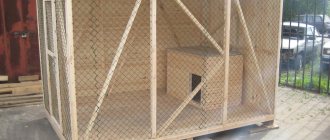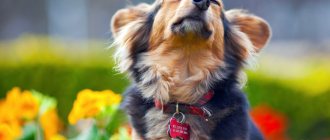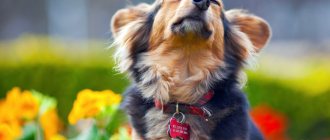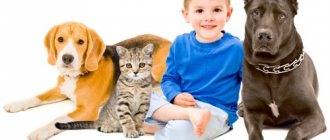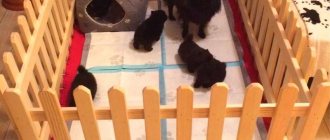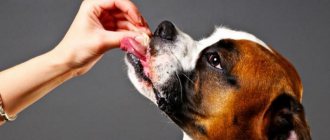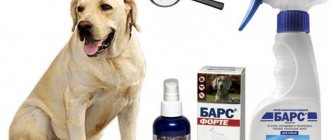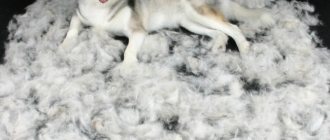The conditions in which a dog is kept have a direct impact on the physical and mental state of the animal, its performance and life expectancy. Dogs spend a significant part of their lives in their habitats. In the house or in the enclosure they rest, play, sleep and recover. If the dog is not able to move and move freely, the pet’s mood worsens and health problems arise. A properly equipped place of detention, on the contrary, has a positive effect on the emotional and physical state of the animal. Therefore, when keeping a dog outside, it is important to arrange the enclosure in such a way that it meets all the requirements and provides the necessary temperature, humidity and air composition.
Dog breeds for keeping outside in a kennel: list
Despite the fact that the dog will live in a booth, it is worth taking care of normal conditions. In winter, the temperature can drop quite low, so it is worth insulating the booth.
Booth requirements:
- Removable roof. This is necessary so that you can properly clean the inside of the dog’s house. Then make sure that the joints between the walls and the roof are airtight. This will prevent water from flowing in during rain. The roof should not be straight, but be inclined. This will ensure rapid drainage of water and snow.
- Insulated walls. It could be polystyrene foam. It perfectly retains heat inside the booth and does not heat up much when exposed to sunlight. Some dogs can chew foam, so you can line the inside of the house with a sheet of USB. The dog will be warm and cozy.
- Sufficient size. The size of the booth should be such that the dog inside it can stand up, sit and turn around normally. At the same time, you should not make a huge booth, since in winter the dog will freeze in it.
- Material. It is best to make a booth from plastic or wood. These materials do not heat up and are easy to clean.
- Entrance. It is best to make the entrance not in the middle, but from the side. This will allow the dog to hide from the wind. In this case, the entrance can be covered with a layer of felt. It is secured at the top and hangs over like a curtain. The dog can easily enter the kennel, but it is also warm and cozy in the winter.
- Floor. It must be made of boards. In this case, it is best to place the booth on legs. In this case, it will not contact the ground. There will be an air cushion between the floor and the ground. Do not cover the floor with a cotton blanket. When wet, it takes a long time to dry and can begin to rot. In addition, many dogs deliberately take all the trash outside the booth. The most interesting thing is that almost none of the pets throw hay out of the kennel.
Dog breeds for keeping outside in a kennel: list
Dog breeds for keeping in a kennel:
- German Shepherd
- Rottweiler
- Asian
- Caucasian
- Husky
- Samoyed
- Laika
- Malamute
Dog breeds for keeping outside in a kennel: list
Shepherd enclosure review
- Author: Anna Nikolaevna Miroshnichenko
Rate this article:
- 5
- 4
- 3
- 2
- 1
(3 votes, average: 2.7 out of 5)
Share with your friends!
Kennel for Husky and Alabai: determining the location and size
Dog kennels: photo and construction technology
What temperature can dogs withstand outside in winter?
It all depends on the breed of the dog and how you trained it. The most interesting thing is that during severe frosts you should not take the dog from the street into the house. This is fraught with molting. In addition, temperature changes make dogs sick. A good owner should be concerned about the dog's health.
List of procedures for severe frosts:
- Improve your pet's diet. At this time, it is necessary to increase the amount of food, since energy costs are quite high. Introduce more proteins and carbohydrates into your diet. Be sure to give your dog plenty of water.
- Insulate the booth. To do this, you need to make sure that the dog’s house does not leak and retains heat well. After this, spread a high cushion of hay.
- Increase the walk time of the pass. If he is in an enclosure, he should let the dog out to run more often. This improves blood circulation and helps keep the dog warm.
- It is worth noting that absolutely healthy pets tolerate cold better. If your dog has arthritis, you should take care of him.
- Vitamins. At this time, give your pets special vitamin complexes. They will improve food absorption and keep the dog healthy.
In general, for breeds such as husky and Asian shepherd, the permissible temperature is -40 °C. These breeds tolerate cold better than heat. Therefore, if you take your pet into the house, it will begin to shed. Thus, the dog gets rid of the undercoat in order to cool the body a little. After this, the dog cannot be kept on the street, otherwise diseases cannot be avoided.
What temperature can dogs withstand outside in winter?
As you can see, some breeds benefit from cold weather rather than hot weather. Dogs such as huskies, collies and grossers are not afraid of snow and tolerate frost well. They feel fine in enclosures and booths even during severe frosts.
Types of enclosures
Based on the material used to make the enclosures, they can be:
- wooden;
- metal;
- combined.
Enclosures can be divided into types by size:
- small;
- average;
- big.
And also depending on the degree of openness and how insulated they are:
- open;
- partially open;
- partially insulated;
- fully insulated over the entire surface.
Buying a dog
If you are interested in how to choose a dog breed, analyze your chart and answer a series of questions that will make it easier for you to choose a breed. Having an animal in the house requires:
- Additional finances. Assess your own financial situation. Will there be enough finances to provide a normal life and adequate nutrition for a newly-made family member?
- Time devoted to a dog of any breed. Requires free time for daily care. The dog requires attentive and careful care, otherwise the pet’s health will begin to deteriorate and its appearance will change for the worse.
- Each puppy certainly brings “joy” to the owners in the form of chewed shoes, piles on the carpet, torn wallpaper and “updated” furniture. It is necessary to evaluate your strength and nerve cells in the ability to perceive spoiled things in the first months of the baby’s life.
- Answer yourself for what purpose the dog is purchased. Do you need a companion, a security guard for your home, or are you planning to become a professional breeder and earn money? There may be no need to purchase an expensive purebred dog if you simply want a companion and friend.
- Sometimes the appearance of a four-legged friend requires the owner to change their daily routine. Will a person be satisfied with such a decision? For 10-15 years, the dog needs to be walked daily, and the walks are supposed to be long. You will have to conduct classes with your pet every day and devote a lot of time and attention to games and education.
- When choosing a dog for your soul, take into account the composition of the family, find out about the presence of allergy sufferers among family members.
- Living conditions (apartment or country house with a plot). Does your living space allow you to have a large breed dog or is it better to limit yourself to a decorative dog? It is hardly appropriate to keep a Labrador or a German Shepherd in a one-room Khrushchev house.
- It is important to consider in advance the possibilities of leaving the dog in another home in case of a necessary departure.
When selecting a breed, answer the questions above honestly and keep in mind that the dog is supposed to have only one owner. Otherwise, the animal will not receive the required education, because it will not understand who to obey. An ill-mannered adult is a headache for owners. When getting a dog, be prepared to accept responsibilities in raising your pet. When preparing a gift, ask the person if he is ready to give half of his time to the little fool.
If a person is confident in his desire and has correctly assessed his own capabilities, an immediate purchase is undesirable. From this moment, a new stage of thinking begins, which dog to choose, decide on goals, size and breed. When choosing a dog, it is important to think through the nuances, including the wishes of family members. Remember, disagreements when choosing a breed or other aspects must be resolved amicably, otherwise the appearance of a long-awaited dog for some family members will negatively affect others. The choice of breed is certainly carried out jointly.
Where to place it?
First, you need to decide on a place on the site where the pen for your four-legged friend will be located in the future. It is undesirable to place the structure at the farthest point. Such a decision can cause the dog to lack communication and begin to make noise, attracting attention. The open wall should face south, southeast or southwest.
You should not place the pen in the yard of a private house next to the fence. This will lead to the pet constantly reacting to passersby. If the dog is a large breed, he will be able to jump out of the yard in winter when there is a lot of snow. In the end, this could end sadly.
It is best to place the enclosure in the front area of the site. Due to this, the dog will be near the gate of a country house or country house and not far from the path. This will allow the animal to see everything that is happening around.
Owner's character
Evaluate yourself as a person. Active athletes and quiet housewives need different dog breeds. There are a number of breeds known that only strong and strong-willed people can handle. Popular decorative breeds will require a lot of time and attention, and are capable of causing scenes of jealousy if someone decides to get closer to their beloved owner or mistress.
If a person has a high degree of activity and is considered a follower of an active healthy lifestyle - he likes cycling, jogging, rollerblading, an active, agile and nimble representative of the dog breed will be suitable. For example, Irish Setter, Husky, Greyhound Italian Greyhound.
Let the calm and balanced future owner take a closer look at retrievers or pugs. Business active people with a strong-willed character can purchase a German Shepherd, Doberman or Rottweiler.
If you are thinking about purchasing a decorative breed, remember that indoor pets require significant attention. Capable of being stubborn, extremely nervous and sensitive.
Most dog trainers and breeders recommend adopting a small puppy. Obvious difficulties with raising and raising are foreseen, but there is firm confidence in the upbringing and disposition of the pet. Some people prefer to adopt an adult dog to avoid the hassles of growing up, hassling with vaccinations, and childhood diseases.
Tips from dog breeders
When placing a dog in an outdoor or indoor enclosure, you should understand that such an enclosure is a home for the pet. The space must be clean and safe. Most dog owners make mistakes when choosing pens, so advice from dog breeders will help you understand the basic issues.
To learn how to build an enclosure for a husky dog, see the following video.
Source
Distinctive features of different breeds
By purchasing a dog, a person acquires a new family member. When choosing, the vast majority of people first of all pay attention to the appearance of a potential four-legged friend. However, few people take into account the fact that dogs have different characters and behavior patterns. Let's take a closer look at the signs that are important when choosing a purebred friend. Here are a dozen smart and intelligent dog breeds:
- Collie.
- Poodle.
- German Shepherd.
- Rottweiler.
- Doberman.
- Labrador, golden retriever.
- Schnauzers.
- Spaniel.
- Belgian Shepherd.
- English cocker spaniel.
Think about your preference - male or female. There are advantages and disadvantages in both cases. During the spring spree, the behavior of the bitch changes noticeably, the males behave a little calmer. Think about whether fussing with your offspring is included in your plans. Males in this regard are less problematic, but are more often self-sufficient and independent.
Any dog requires coat care. Select breeds require constant brushing and grooming. If you plan to keep a pet in an apartment, be prepared to constantly remove hair from the carpets. Consider the possibility of allergic reactions to dog hair in family members. Poodles are considered low-allergenic to humans.
Gender of the dog
This is an important nuance; males and females require different care. Both genders exhibit positive and negative traits.
Bitches
According to dog experts, female dogs are often emotionally unprotected and become much closer to humans than individuals of the opposite sex. It is believed that girls perceive educational procedures more easily, are flexible, and, with the appropriate documents, are used for breeding puppies. The female is attracted to male dogs no more than 2 times a year, and the presence of admission opens up the possibility of breeding for the owners.
Added to the obvious disadvantages of keeping female dogs are the danger of unplanned pregnancy and estrus. Difficulties with false pregnancy and complications associated with this are often noted. If you do not plan to breed puppies, you should think about sterilization. There is no need to talk further about care and increased attention during pregnancy.
Males
Males are emotionally more assertive, energetic, characterized by recklessness and uncontrollable joy. We are happy to give our owners positive emotions every day, without giving them peace. Among the positive qualities of a male dog are increased activity and the absence of difficulties associated with pregnancy. There are no restrictions regarding participation in competitions and exhibitions, which is explained by the highest degree of compliance with breed standards.
Disadvantages include increased interest in the opposite sex, all year round. The desire to dominate and take a leading position is expressed. The education of a male dog, mainly of a service breed, should be given increased attention. With the right and clear approach, they can show stunning results as a result of training.
Choosing a dog for an apartment
People get dogs to have a best friend and helper in psychological matters. It’s not boring to play sports with a dog, it’s fun to go fishing or hunting. But when getting a pet, it’s rare that a person will think about the comfort of a dog’s stay in a city apartment.
Having a large breed of dog as a pet in an urban apartment is unsafe and difficult. The dog will need to be walked, and in places where there are no people or other animals. Agree that there are catastrophically few such places in cities. Secondly, a large dog needs a large space, with its own place and personal territory. This is difficult in apartments with a total area of 40 square meters, where, in addition to the dog, there is also a human family. Medium and small breeds of dogs are mainly suitable for keeping in city apartments.
The nuances of keeping dogs in an apartment
- Walk. An adult dog needs to be walked 2-3 times a day, and one walk is supposed to be long. In urban conditions, it is not recommended to let the animal out into the street without the supervision of the owner (as is practiced in villages and villages); this poses a danger to the dog and surrounding people.
- Vaccinations. If you want to have a healthy dog and minimize the risk of contracting infectious diseases in your family, you will have to get regular vaccinations. A domestic dog is often shown to a veterinarian; the animal is more susceptible to diseases and ailments.
- Training. You should not neglect the education and training of city dogs. This is much more important than training a wolfhound sitting on a chain in the village.
- Safety. People who keep large service dogs in their apartments have a responsibility to ensure the safety of those around them. An untrained and uncontrolled animal poses a great threat to the life and health of neighbors.
Medium breeds
There are many medium-sized dog breeds for apartments. Let's look at the popular representatives of the subgroup.
- Poodle. A beautiful, smart and cheerful animal will become a beloved family member. It is recommended to purchase this breed of dog for families with children. Often, older single people choose a dog breed because of its kindness, sincerity and balance. The only difficulty in keeping it is regular grooming. The poodle needs to be combed daily and, if necessary, cut.
- English cocker spaniel. Since ancient times, the dog was intended for hunting, but today it is common in apartments. This is a kind dog breed that gets along well with children and other pets. Does not require special efforts in education and training. Unpretentious and smart. Before buying a breed, keep in mind that the English Cocker Spaniel needs long walks, and the dog is also given time to run around as much as possible.
- Boxer. An intelligent and willful dog will bring a lot of joy and happy moments in the life of a family. The dog breed demands respect. There are no shortcomings of the breed, except for the fact: when raising a puppy, you will need to constantly support the owner's leadership.
Small breeds
Small breeds of apartment dogs serve as both friends and protectors.
- Pug. Funny dogs willingly become family members. They are able to support the child in the game, help mom concentrate in the kitchen and enjoy watching football on TV with dad. It is unlikely that you will find a more sociable dog. Pugs are reluctant to train, but they are able to understand a person at first sight, provided there is complete mutual understanding.
- Scotch Terrier. In ancient times, it was a hunting dog breed, but thanks to its excellent watchdog qualities, the dog became a domestic dog. The Scottish Terrier is a wayward dog, distrustful of others and rarely accepts more than one owner.
Small dog breeds for apartments
Small breeds of dogs for apartments are becoming very popular today. Dogs are often bought as an addition to the graceful appearance of the owner or owner.
- Pekingese. It is considered the best representative of small dog breeds intended for living in an apartment. The Pekingese is unpretentious in food, unobtrusive, uncapricious and always adapts to its owner. To keep your dog looking its best, it is important to keep its coat clean and smooth.
- Toy Terrier. The most popular small domestic dogs today. The babies have a capricious character, are unfriendly to strangers and are often susceptible to diseases. If you decide to purchase a toy terrier, you should be prepared to give the dog exceptional attention and care.
Smooth-haired and long-haired dogs
Undoubtedly, smooth-haired dog breeds are more suitable for apartments than long-haired ones. They do not require a picky attitude towards their fur, do not shed and do not bring back attached burrs from a walk. But smooth-haired dogs also need coat care. Dogs are supposed to be brushed with special brushes.
Calm dog breeds are recommended more often than mischievous ones for keeping in an apartment. Quiet representatives of dog breeds are considered: collies, Labradors, and retrievers.
Accommodations
If the owner decides to keep a Labrador in an apartment, he must provide him with a place to rest and sleep. Place appropriately sized bedding away from drafts and central heating radiators. Buy your pet bowls for food and water, toys for combing gums, and grooming products.
It is much more convenient for a retriever to live in a private house. Moreover, when the puppy reaches one year of age, he can permanently live in the yard.
To make it comfortable to keep a Labrador outdoors in winter, the owner must build him a spacious enclosure and a warm booth. The dog will hide in it from frost, rain, and strong winds.
If these conditions are met, you can keep your Labrador Retriever outside even at temperatures of 15-20° below zero. In the summer heat, the dog will relax in the fresh air in the shade of trees. Such living is much more comfortable for a dog than in stuffy apartments with a dangerous draft from air conditioners.
The lifespan of a Labrador does not depend on where the dog sleeps. After all, breed-specific diseases can appear in both “apartment” and “street” pets. These include:
- joint dysplasia - destruction of joint and bone tissue due to an increased gap between the acetabulum and the head;
- acral dermatitis - itchy inflammation on the skin of the paws, which appears due to excessive, obsessive licking;
- cataract – destruction of the internal tissue of the eye, which leads to clouding of the lens;
- epilepsy is a disease that manifests itself as seizures due to a disorder of the brain;
- lymphoma is a malignant tumor that affects the tissues of the lymphatic system;
- otitis is an inflammation of the tissues of the inner ear, which appears due to decreased immunity, injury, and infection with parasites.
In addition, Labradors often suffer from allergies to foods, tree pollen, and flea saliva.
Guard dog
Progress does not stand still. Despite the use of high technology, people, as before, strive to have a dog capable of guarding the territory. Statistics show that most intruders are much more influenced by the presence of a formidable guard in the form of a dog than by a security alarm and CCTV cameras.
For hundreds of years, leading positions in the field of protection have been occupied by shepherds and fighting dogs, for example, boxers, mastiffs, and Rottweilers. Do not think that only the listed breeds are suitable as guards. For apartment living, it is better to choose a less dangerous and calmer variety of guard dogs. For example, a bulldog or sharpei becomes full-fledged apartment security guards and wonderful companions.
When choosing a dog to guard your home, consider the needs and size of the animal. Guard dogs are designed to constantly exercise and move. Dogs are given space. These dogs are not kept on a chain. An aviary would be an ideal place. Pets will require a lot of owner's time. You will have to provide:
- Daily long walks, preferably without a leash.
- Daily workouts.
- Strict daily routine regarding feeding.
Watchdogs are required to undergo socialization, and at an early stage of life, otherwise people and animals in the area will have a hard time. Choosing a dog to guard your home does not just mean purchasing one. Without special attention, such dogs will instantly turn into uncontrollable monsters. Consider the fact that a guard dog will not survive without a lot of free space.
Owning a representative of a guard breed in an apartment environment will require the owner to take constant and long walks. Moreover, a spacious area, fenced or remote from people, is selected as a walking area. A guard dog is supposed to be let off the leash so that it can run around and burn off its energy. Private territory will allow you to avoid these difficulties.
Hunting dog
Choosing a dog for hunting means choosing an excellent companion and family member. These dogs include Labradors and retrievers, huskies and Dalmatians, spaniels and terriers, basset hounds and other wonderful breeds. The animals are ideal for large families with small children.
Breeds do not strive to dominate; they tend to please their owners. Representatives of the breed need constant movement. Energetic games with family members in the fresh air are ideal.
It is acceptable to keep in a house or apartment. But living in an apartment requires daily long walks. Hunting has accustomed representatives of hunting species to constant movement. Animals are often hyperactive.
In the group of companion dogs, otherwise known as caregivers, the leading positions are occupied by retrievers and Labradors. The breeds are amazing and unique, they become irreplaceable loyal friends and helpers for humans, it is easy to talk to dogs - the animals will become excellent listeners and grateful family members.
How to determine the breed of a dog
To determine the breed of dogs, special identifiers have been developed. Pedigree dogs are described in detail in special standards by which selection is made at exhibitions and for breeding.
Algorithm for determining breed by external characteristics:
- Determine the dimensions of the dog - measure the height at the withers, determine the body format using a tape measure.
- Take a closer look at the shape of your pet's head and muzzle. Determine the format of the body: the ratio of the length of the body and the height of the dog.
- Important characteristics are the shape and fit of the ears, the shape and position of the animal's tail, the color and character of the coat.
- Find a good reference book for the definition. Use printed publications and information from the Internet; it is better to combine information: a single source will not provide comprehensive data.
- If you find a similar photo, carefully study the description of the standards. Difficulties arise with mestizos, with detecting signs of several bloods at the same time.
- To guarantee, check with your veterinarian or kennel club. In large cities, specialized veterinary clinics have been established where it is possible to order a genetic examination of a pet. A reliable way is to purchase a puppy with documents from a professional breeder with a decent reputation.
Summing up
Conventionally, known breeds are divided into 4 groups, determined in connection with the main purposes of the representatives included in each group of breeds. Guard breeds are popular and in demand today. Representatives of the hunting group are no less popular. When choosing a breed, try to evaluate your own nature in an extremely honest way, then it will be much easier to choose.
For example, a lazy or overly busy person at work is clearly not suitable for an overactive pet that requires an active lifestyle. A small decorative puppy will not tolerate hard, energetic training. A person with a gentle character will not need to have a representative of the fighting breed. Dogs sense the slightest weakness of the owner and use the mistake to their own advantage. Representatives of service breeds are also not ideal for a gentle person, requiring strictness.
A dog is a man’s friend and often reflects the essence of its owner. Try to choose a pet that matches your own character. Then it will be much easier to find a common language with the animal.
In order not to be mistaken about which dog is best to bring into a private home, you need to carefully study the breeds and determine what exactly a four-legged friend is needed for. Most often it is purchased for protection.
Peculiarities
A guard dog, regardless of its breed and location, needs an enclosure that will be considered its personal corner. The owner can make such a space for a pet independently or purchase a ready-made structure. There are hundreds of models on sale, from which you can choose the best option.
To make your dog’s enclosure as comfortable as possible, you need to study its features.
Knowing the features that every dog enclosure must have, you will be able to create suitable conditions for keeping your pet and make it easier for yourself to care for the premises, making communication with your four-legged friend even more enjoyable.
General criteria
Since the animal will spend a lot of time outside, it needs a powerful undercoat to protect it from winter cold, endurance, strength and high learning abilities.
General rules for choosing a dog for a private home:
- You should not have hunting dogs. Friendliness will not allow them to become reliable guards, and their hunting instinct will be a threat to other pets.
- Fighting breeds are bred specifically for fighting. It is dangerous to develop the aggression necessary for protection in them, so they are also not suitable.
- Rescue dogs such as the Labrador or Newfoundland, despite their intimidating size, are very friendly. You can have them if there are small children in the family. They will become loyal friends and protectors, but are unlikely to be ferocious guards over a vast territory.
It is important to determine the size and gender of the animal. Large dogs require more attention. They need regular physical activity and training to tame their temper and teach them to obey all the owner’s commands. The bitch is easier to train, she has a gentle character. The male dog is more stubborn and needs more rigorous training.
Below are dog breeds that were specifically created to serve as guard dogs.
The best breeds for guarding a private home
Alabai
Alabai is an ancient breed, distinguished by its loyalty to its owner and is a reliable protector of the family and home. Her large athletic build allows her to stand up for her assigned area in any situation.
Alabais have a large head with a powerful lower jaw, small drooping triangular ears that need to be cropped, a short neck and a massive chest. Dogs' paws are strong and very strong. The thickened tail is usually trimmed. The height of an adult animal at the withers is about 70 cm, weight is from 50 to 65 kg.
Alabai requires strict proper upbringing so that he cannot feel superior to a person, otherwise his presence in the house will bring many problems.
The guard breed is aggressive towards other people's dogs and always warns uninvited guests about itself with a loud growl.
Caucasian Shepherd Dog
According to many experts, this is one of the best guard breeds. Her main qualities are courage, determination and courage. Caucasian Shepherds are incredibly smart, so they can make their own decisions in difficult situations. At the moment of danger, they do not show aggression, but attack without warning.
These loyal, fearless dogs have an alert, independent nature. They strive to constantly control the territory, are suspicious of strangers and respond well to training, which must begin as early as possible.
These dogs need a free enclosure and regular exercise so they can burn off their energy. The weight of the Caucasian Shepherd is on average 45-50 kg, height at the withers is up to 70 cm.
We recommend reading: Description of the Bernese Mountain Dog breed, features of care and maintenance.
Moscow watchdog
She knows no fear, so she never retreats before the enemy. A powerful, strong animal is a worthy option for protecting a private home and its surrounding area.
The character of Moscow guard dogs is softer than that of Alabais or Caucasian Shepherds. With proper upbringing, they become not only excellent guards, but also reliable friends of all family members.
Thick wool allows them to feel comfortable in the cold and protect their territory in cold climates. Moscow guard dogs need free space. On a short chain they are too aggressive and sullen.
The height of the animals reaches 69 cm, weight varies from 45 to 70 kg. The breed is suitable for people who are willing to devote significant time to training a dog.
Tibetan mastiff
This is an ancient and rare breed that originated in the Himalayan mountains. Initially, she guarded only Tibetan monks and nomads. The first representatives of animals were brought to the West in the middle of the 19th century.
The Tibetan Mastiff is a tall, powerful dog with a muscular neck and a thick mane covering the withers. She has a wide, square head, triangular floppy ears and expressive eyes. The paws are strong and strong, the fluffy tail is curled behind the back. Its long fur and beautiful mane make it look like a lion.
Tibetan Mastiffs are smart, quick-witted and stubborn. They love to assert their independence, so owners need to devote a lot of time to training so that the dogs do not become uncontrollable.
While guarding the house, they constantly check the territory and bark loudly and gutturally if they feel a stranger approaching.
Doberman
The short-haired, lean breed can often be seen in police service. These faithful, graceful animals are moderately aggressive, balanced, have a stable psyche and are excellent for guarding a private home.
In case of danger, they, without hesitation, rush to the aid of the owner and protect him, not sparing his life. If you spend significant time training Dobermans, they turn into good bodyguards.
These dogs cannot be kept in an enclosure 24/7. They need human interaction, walks and games. Exercise is necessary to maintain endurance.
We recommend reading: Raising and training a Doberman at home
Boerboel
These large oversized dogs are designed to protect people and their property. They are harmoniously built and capable of moving with lightning speed, leaving no chance for attackers to escape.
Boerboels are not characterized by unmotivated aggression and excessive malice. They are loyal to children and pets. Like many guard breeds, these dogs have an independent, stubborn disposition and strive for dominance. Therefore, they need a firm hand and quality training.
We recommend reading: Characteristics and description of the bullmastiff breed.
Cane Corso
The Italian breed is an ideal guardian of a personal plot. He easily distinguishes friends from enemies and shows aggression only when it is necessary.
The Cane Corso (Italian Mastiff) feels comfortable in a large enclosure, but must be allowed out into the yard regularly. To avoid surprises, the owner should acquire a high, impenetrable fence.
Dogs of this breed begin to be trained from early childhood in order to achieve complete obedience. The owner must be the unconditional leader for the Cane Corso, then the animal will know its place and become a devoted protector and guard.
Black Russian Terrier
The breed was specially bred for service, so its protective qualities are inherent in it at the genetic level. She has excellent reactions, observation and courage.
Black Russian Terriers are loyal and quick to train dogs. They need a decisive and strict owner who will show not only firmness, but also love towards them. Animals are extremely suspicious of strangers, so from childhood they must be taught to obey and follow commands so that they do not create trouble for the owner.
Regardless of what breed of dog you choose to bring into your private home, do not forget that any of them requires attention and training. The animal must understand and follow all orders. To achieve this, it is advisable to contact an experienced dog handler to have your dog undergo an obedience and protection course.
Advantages and disadvantages
Indoor kennels are in fairly high demand among owners of small and medium-sized dogs, which is due to the many undeniable advantages of their use.
Among the disadvantages of home models, they note the limitation of the animal’s mobility, especially if it is kept in a closed enclosure for too long. In this regard, it is recommended to let the dog out at least twice a day, and the walk should last at least 20 minutes.
The modern market for animal products offers a wide range of indoor enclosures. Among them there are soft mini-models for very small breeds, and reinforced designs for medium-sized pets. Classification of apartment fencing is made according to two main criteria: material of manufacture and shape of the structure. Each type has its own strengths and weaknesses, as well as a number of features, which will be discussed below.
By shape
The shape of enclosures can be very diverse. The most practical and common are rectangular structures, which are usually installed in the corner of the room and, unlike round samples, do not take up excess space. But round and polygonal playpens are convenient for installation in the middle of a large room: such structures do not distort the space and are easier to walk around.
As for the size of the enclosure, it should be such that the pet can stretch out freely, lie down comfortably and walk a little. Most ready-made playpens consist of modules that can be added or removed depending on need.
By material
Home dog enclosures are made of metal, plastic, fabric and wood.
Plastic models are the lightest and most inexpensive. They have a composite design and consist of individual modules. This allows you to experiment with shape and size, assembling one large structure from several arenas or, conversely, dividing one enclosure into several separate ones. The advantages of plastic models include ease of assembly and ease of maintenance. Such models do not absorb moisture and can be treated with any detergent.
The disadvantages of plastic enclosures include too little weight, which is why even a not very large dog can easily move it. The way out of the situation is suction cups, which firmly fix the structure to the floor and do not allow it to move under the pressure of the animal. Another significant disadvantage of plastic playpens is the relative softness of the material, which is why it is not recommended to purchase models for puppies and dogs that chew things.
Such an enclosure is perfect for a puppy or a small adult dog.
An aviary-tent with a metal frame is the most impractical type of fencing and is not suitable for permanent use. Such models are well suited as a temporary structure, for example, for going out into nature or to the country. The advantage of tent models is low cost, light weight, as well as ease of transportation and storage. The disadvantages include the tendency to quickly become dirty and absorb unpleasant odors. In addition, the most active dogs can easily chew through the fabric base and get out.
A metal folding enclosure is the best option for home fencing and is suitable for any dog. The model is a collapsible structure consisting of wire modules made in the form of a mesh. The advantages of this type are: long service life, resistance to chewing of metal rods and excellent hygienic characteristics. The fences are easy to clean with any liquid product and retain their attractive appearance for a long time. The disadvantages of metal structures include the inconvenience of transporting long sections and the likelihood of scratching the floor if the pet is too active and moves the enclosure.
Wooden models look very noble and harmonize perfectly with furniture and home design. The advantages of such playpens include an attractive appearance and a completely environmentally friendly design. Among the disadvantages are the risk of segments being chewed, a tendency to swell from excess moisture and high cost. In addition, the side panels are of one-piece construction and often do not fit into the trunk of a car.
Thus, the most versatile and practical are plastic and metal models. Therefore, it is better for novice dog breeders and those with no training experience to purchase them.
